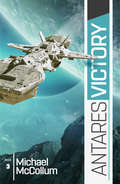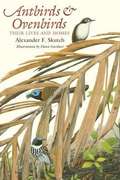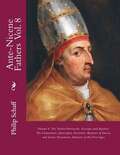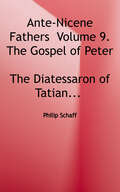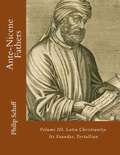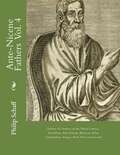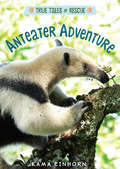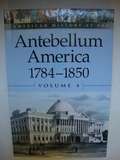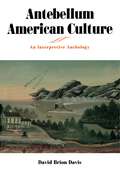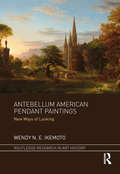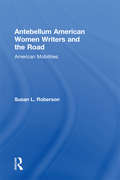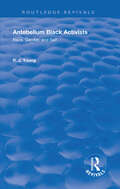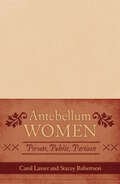- Table View
- List View
Antares Victory: 2019 Edition (Antares Trilogy #3)
by Michael McCollumAfter a century of warfare, humanity finally discovered the Achilles heel of the Ryall, their xenophobic reptilian foe. Spica – Alpha Virginis – is the key star system in enemy space. It is the hub through which all Ryall starships must pass, and if Alta and their allies can just capture and hold it, they will strangle the Ryall war machine and end its threat to humankind forever.It all seemed so simple in the computer simulations: Advance by stealth, attack without warning, strike swiftly with overwhelming power. Unfortunately, the logistics prove to be the easy part. With the key to victory in hand, Richard and Bethany Drake must temper the volatile role of human nature if they are to bring down the alien foe…
Antbirds and Ovenbirds
by Alexander F. Skutch Dana GardnerAntbirds and ovenbirds, two of the five largest families of birds found only in the Western Hemisphere, have been among Alexander Skutch's favorites for more than six decades. In this book, he draws on years of observations to describe the life cycle of these fascinating birds, which inhabit Latin America from tropical Mexico to Tierra del Fuego. Skutch covers all aspects of the birds' lives, including the various species in each family, food and foraging, daily life, voice, displays and courtship, nests and incubation, and parental care. He also recounts anecdotes from his own experiences, creating vivid pictures of antbirds foraging for the insects Skutch stirs up on walks through the rainforest and of ovenbirds repairing the observation holes that he opens in their elaborate nests. As some of tropical America's least studied birds, antbirds and ovenbirds surely merit the extensive treatment given them here by one of our most distinguished senior ornithologists. Over fifty line drawings by noted bird artist Dana Gardner make this book a delight for both armchair and field naturalists.
Ante Up (Dreamspun Beyond #8)
by Kim FieldingLove is a high-stakes game. A century and a half ago, Ante Novak died on a Croatian battlefield—and rose three days later as a vampire. Now he haunts Las Vegas, stealing blood and money from drunken gamblers and staying on the fringe of the powerful vampire organization known as the Shadows. His existence feels empty and meaningless until he meets beautiful Peter Gehrardi, who can influence others with his thoughts. An attraction flares instantly, bringing a semblance of life to Ante’s dead heart. But the Shadows want Peter too, and they’re willing to kill to get him. As Ante and Peter flee, they learn more about themselves and each other, and they discover that the world is a stranger place than either of them imagined. With enemies at their heels and old mistakes coming back to exact a price, how can Ante and Peter find sanctuary?
Ante-nicene Fathers: Volume 5. Fathers Of The Third Century: Hippolytus, Cyprian, Caius, Novatian (Ante-nicene Fathers Ser.)
by Philip Schaff Arthur CoxeThis fifth volume will be found a work complete in itself, simplex et Unum. At first, indeed, it might look otherwise. The formation of Latin Christianity in the school of North Africa seems interrupted by the interpolation, between Tertullian and his great pupil Cyprian, of a Western bishop and doctor, who writes in Greek. A little reflection, however, will suggest to the thoughtful student, that, even if our chronological plan admitted of it, we should divest the works of Cyprian of a very great advantage should we deprive them of the new and all-important light shed upon Cyprian and his conflicts with Stephen by the discovery of the Philosophumena of Hippolytus.
Ante-nicene Fathers: Volume 6. Fathers Of The Third Century: Gregory Thaumaturgus, Dionysius The Great, Julius Africanus, Anatolius And Minor Writers, Methodius, Arnobius (Ante-nicene Fathers Ser.)
by Philip Schaff Arthur CoxeIn this volume a mass of fragmentary material [1] has been reduced to method, and so harmonized as to present an integral result. The student has before him, therefore, (1) a view of the Christian Church emerging from the ten persecutions; (2) a survey of its condition on the eve of that great event, the (nominal) conversion of the empire; (3) an introduction to the era of Athanasius; and (4) a history of events that led to the calling of the first Catholic council at Nicæa.
Ante-nicene Fathers: Volume 7. Fathers Of The Third And Fourth Centuries: Lactantius, Venantius, Asterius, Victorinus, Dionysius, Apostolic Teaching And Constitutions, Homily (Ante-nicene Fathers Ser.)
by Philip Schaff Arthur CoxeThe genius of Lactantius suffers a sad transformation when unclothed of vernacular and stripped of the idiomatic graces of his style. But the intelligent reader will be sure to compare this translation with the Latinity of the original, and to recur to it often for the enjoyment of its charming rhetoric, and of the high sentiment it so nobly enforces and adorns. This volume will be the favourite of the series with many. The writings of the Christian Tully alone make up more than half of its contents; and it is supremely refreshing to reach, at last, an author who chronicles the triumph of the Gospel [1] over "Herod and Pontius Pilate;" over the heathen in their "rage," and the people in their "vain imaginings;" over "the kings of the earth who stood up, and the rulers who were gathered together against the Lord and against His Christ."
Ante-nicene Fathers: Volume 8. The Twelve Patriarchs, Excerpts And Epistles, The Clementina, Apocrypha, Decretals, Memoirs Of Edessa And Syriac Documents, Remains Of The First Ages (Ante-nicene Fathers Ser. #8)
by Philip Schaff Arthur CoxeVolume 8: The Testaments of the Twelve Patriarchs Excerpts of Theodotus Two Epistles Concerning Virginity Pseudo-Clementine Literature Apocrypha of the New Testament The Decretals Memoirs of Edessa And Other Ancient Syriac Documents Remains of the Second and Third Centuries
Ante-nicene Fathers: Volume 9. The Gospel of Peter, The Diatessaron of Tatian, The Apocalypse of Peter, The Vision of Paul, The Apocalypses of The Virgin and Sedrach and More (Ante-nicene Fathers Ser.)
by Philip SchaffVolume 9: The Gospel of Peter, The Diatessaron of Tatian, The Apocalypse of Peter, The Vision of Paul, The Apocalypse of the Virgin, The Apocalypse of Sedrach, The Testament of Abraham, The Acts of Xanthippe and Polyxena, The Narrative of Zosimus, The Epistles of Clement, The Apology of Aristides the Philosopher, The Passion of the Scillitan Martyrs, Epistle to Gregory and Origen's Commentary on the Gospel of John, Origen's Commentary on the Gospel of Matthew
Ante-nicene Fathers: Volume I. Apostolic Fathers With Justin Martyr And Irenaeus (Ante-nicene Fathers Ser.)
by Philip Schaff Arthur Coxe Alexander Roberts James DonaldsonThis volume, containing the equivalent of three volumes of the Edinburgh series of the Ante-Nicene Fathers, will be found a library somewhat complete in itself. The Apostolic Fathers and those associated with them in the third generation, are here placed together in a handbook, which, with the inestimable Scriptures, supplies a succinct autobiography of the Spouse of Christ for the first two centuries. No Christian scholar has ever before possessed, in faithful versions of such compact form, a supplement so essential to the right understanding of the New Testament itself. It is a volume indispensable to all scholars, and to every library, private or public, in this country.
Ante-nicene Fathers: Volume II. Fathers Of The Second Century: Tatian, Theophilus Of Antioch, Athenagoras Of Athens, Clement Of Alexandria (Ante-nicene Fathers Ser.)
by Philip Schaff Arthur Coxe Alexander Roberts James DonaldsonThe series was originally published between 1867 and 1873 by the Presbyterian publishing house T. & T. Clark in Edinburgh under the title Ante-Nicene Christian Library (ANCL), as a response to the Oxford movement's Library of the Fathers which was perceived as too Roman Catholic. The volumes were edited by Rev. Alexander Roberts and James Donaldson. This series was available by subscription, but the editors were unable to interest enough subscribers to commission a translation of the homilies of Origen.
Ante-nicene Fathers: Volume III. Latin Christianity: Its Founder, Tertullian (Ante-nicene Fathers Ser. #3)
by Philip Schaff Arthur Coxe Alexander Roberts James DonaldsonVolume III. Latin Christianity: Its Founder, Tertullian
Ante-nicene Fathers: Volume IV: Fathers Of The Third Century: Tertullian, Part Fourth, Minucius Felix, Commodian, Origen, Parts First And Second (Ante-nicene Fathers Ser. #4)
by Philip Schaff Arthur CoxeVolume IV. Fathers of the Third Century: Tertullian, Part Fourth, Minucius Felix, Commodian, Origen, Parts First and Second
Anteaesthetics: Black Aesthesis and the Critique of Form (Inventions: Black Philosophy, Politics, Aesthetics)
by Rizvana BradleyIn Anteaesthetics, Rizvana Bradley begins from the proposition that blackness cannot be represented in modernity's aesthetic regime, but is nevertheless foundational to every representation. Troubling the idea that the aesthetic is sheltered from the antiblack terror that lies just beyond its sanctuary, Bradley insists that blackness cannot make a home within the aesthetic, yet is held as its threshold and aporia. The book problematizes the phenomenological and ontological conceits that underwrite the visual, sensual, and abstract logics of modernity. Moving across multiple histories and geographies, artistic mediums and forms, from nineteenth-century painting and early cinema, to the contemporary text-based works, video installations, and digital art of Glenn Ligon, Mickalene Thomas, and Sondra Perry, Bradley inaugurates a new method for interpretation—an ante-formalism which demonstrates how black art engages in the recursive deconstruction of the aesthetic forms that remain foundational to modernity. Foregrounding the negativity of black art, Bradley shows how each of these artists disclose the racialized contours of the body, form, and medium, even interrogating the form that is the world itself. Drawing from black critical theory, Continental philosophy, film and media studies, art history, and black feminist thought, Bradley explores artistic practices that inhabit the negative underside of form. Ultimately, Anteaesthetics asks us to think philosophically with black art, and with the philosophical invention black art necessarily undertakes.
Anteater Adventure (True Tales of Rescue)
by Kama EinhornAn up‑close look at what life is like the morning after a terrible hurricane for anteater Abi in this photo‑packed series exploring the stories and science behind animal sanctuaries. Abi takes readers behind the scenes of an anteater sanctuary in Belize in this nonfiction chapter book for elementary‑aged readers. Includes full‑color photos, graphics, and maps.
Anteaters (Nature's Children)
by Lorien KiteIntroduces the reader to anteaters, where they live, what they eat, their young and more.
Antebellum America: 1784-1850 (American History By Era Series #Volume 4)
by William DudleyThe time between America's independence in 1783 and the year 1850 was an era of remarkable growth in territory and power for the new nation, as well as a time of social ferment and change. <P><P>Americans created a constitutional government, expanded westward, and grappled with the problem of slavery.
Antebellum American Culture: An Interpretive Anthology
by David Brion DavisFirst published in 1979, this volume offers students and teachers a unique view of American history prior to the Civil War. Distinguished historian David Brion Davis has chosen a diverse array of primary sources that show the actual concerns, hopes, fears, and understandings of ordinary antebellum Americans. He places these sources within a clear interpretive narrative that brings the documents to life and highlights themes that social and cultural historians have brought to our attention in recent years. Beginning with the family and the issue of socialization and influence, the units move on to struggles over access to wealth and power; the plight of "outsiders" in an "open" society; and ideals of progress, perfection, and mission. The reader of this volume hears a great diversity of voices but also grasps the unities that survived even the Civil War.
Antebellum American Culture: An Interpretive Anthology
by David Brion DavisFirst published in 1979, this volume offers students and teachers a unique view of American history prior to the Civil War. Distinguished historian David Brion Davis has chosen a diverse array of primary sources that show the actual concerns, hopes, fears, and understandings of ordinary antebellum Americans. He places these sources within a clear interpretive narrative that brings the documents to life and highlights themes that social and cultural historians have brought to our attention in recent years. Beginning with the family and the issue of socialization and influence, the units move on to struggles over access to wealth and power; the plight of "outsiders" in an "open" society; and ideals of progress, perfection, and mission. The reader of this volume hears a great diversity of voices but also grasps the unities that survived even the Civil War.
Antebellum American Pendant Paintings: New Ways of Looking (Routledge Research in Art History)
by Wendy N. IkemotoAntebellum American Pendant Paintings: New Ways of Looking marks the first sustained study of pendant paintings: discrete images designed as a pair. It opens with a broad overview that anchors the form in the medieval diptych, religious history, and aesthetic theory and explores its cultural and historical resonance in the 19th-century United States. Three case studies examine how antebellum American artists used the pendant format in ways revelatory of their historical moment and the aesthetic and cultural developments in which they partook. The case studies on John Quidor’s Rip Van Winkle and His Companions at the Inn Door of Nicholas Vedder (1839) and The Return of Rip Van Winkle (1849) and Thomas Cole’s Departure and Return (1837) shed new light on canonical antebellum American artists and their practices. The chapter on Titian Ramsay Peale’s Kilauea by Day and Kilauea by Night (1842) presents new material that pushes the geographical boundaries of American art studies toward the Pacific Rim. The book contributes to American art history the study of a characteristic but as yet overlooked format and models for the discipline a new and productive framework of analysis focused on the fundamental yet complex way images work back and forth with one another.
Antebellum American Women Writers and the Road: American Mobilities (Routledge Studies In Nineteenth Century Literature Ser. #5)
by Susan L. RobersonA study of American women’s narratives of mobility and travel, this book examines how geographic movement opened up other movements or mobilities for antebellum women at a time of great national expansion. Concerned with issues of personal and national identity, the study demonstrates how women not only went out on the open road, but participated in public discussions of nationhood in the texts they wrote. Roberson examines a variety of narratives and subjects, including not only traditional travel narratives of voyages to the West or to foreign locales, but also the ways travel and movement figured in autobiography, spiritual, and political narratives, and domestic novels by women as they constructed their own politics of mobility. These narratives by such women as Margaret Fuller, Susan Warner, and Harriet Beecher Stowe destabilize the male-dominated stories of American travel and nation-building as women claimed the public road as a domain in which they belonged, bringing with them their own ideas about mobility, self, and nation. The many women’s stories of mobility also destabilize a singular view of women’s history and broaden our outlook on geographic movement and its repercussions for other movements. Looking at texts not usually labeled travel writing, like the domestic novel, brings to light social relations enacted on the road and the relation between story, location, and mobility.
Antebellum Black Activists: Race, Gender, and Self
by R. J. YoungFirst published in 1996. In this volume the author has collected several published works to explore the ideas of manhood in America, Sojourner Truth, ties of ordinary blacks to those still in slavery and a study of the Northern African American community; new information on black activities in Canada and begins with an essay on the five elements of black community activity before the Civil War: churches, newspapers, conventions, organizations, and emigration which looks at of these "platforms for change" going through developmental stages from experimentation, adjustment and reaching maturity in the 1850’s.
Antebellum Posthuman: Race and Materiality in the Mid-Nineteenth Century
by Cristin EllisFrom the eighteenth-century abolitionist motto “Am I Not a Man and a Brother?” to the Civil Rights-era declaration “I AM a Man,” antiracism has engaged in a struggle for the recognition of black humanity. It has done so, however, even as the very definition of the human has been called into question by the biological sciences. While this conflict between liberal humanism and biological materialism animates debates in posthumanism and critical race studies today, Antebellum Posthuman argues that it first emerged as a key question in the antebellum era. In a moment in which the authority of science was increasingly invoked to defend slavery and other racist policies, abolitionist arguments underwent a profound shift, producing a new, materialist strain of antislavery. Engaging the works of Douglass, Thoreau, and Whitman, and Dickinson, Cristin Ellis identifies and traces the emergence of an antislavery materialism in mid-nineteenth century American literature, placing race at the center of the history of posthumanist thought. Turning to contemporary debates now unfolding between posthumanist and critical race theorists, Ellis demonstrates how this antebellum posthumanism highlights the difficulty of reconciling materialist ontologies of the human with the project of social justice.
Antebellum Slave Narratives: Cultural and Political Expressions of Africa (Studies in American Popular History and Culture)
by Jermaine O. ArcherThough America experienced an increase in a native-born population and an emerging African-American identity throughout the nineteenth century, African culture did not necessarily dissipate with each passing decade. Archer examines the slave narratives of four key members of the abolitionist movement—Frederick Douglass, William Wells Brown, Harriet Tubman and Harriet Jacobs—revealing how these highly visible proponents of the antislavery cause were able to creatively engage and at times overcome the cultural biases of their listening and reading audiences. When engaged in public sphere discourses, these individuals were not, as some scholars have suggested, inclined to accept unconditionally stereotypical constructions of their own identities. Rather they were quite skillful in negotiating between their affinity with antislavery Christianity and their own intimate involvement with slave circle dance and improvisational song, burial rites, conjuration, divination, folk medicinal practices, African dialects and African inspired festivals. The authors emerge as more complex figures than scholars have imagined. Their political views, though sometimes moderate, often reflected a strong desire to strike a fierce blow at the core of the slavocracy.
Antebellum Women: Private, Public, Partisan (American Controversies)
by Carol Lasser Stacey RoberttsonHow did diverse women in America understand, explain, and act upon their varied constraints, positions, responsibilities, and worldviews in changing American society between the end of the Revolution and the beginning of the Civil War? Antebellum Women: Private, Public, Partisan answers the question by going beyond previous works in the field. The authors identify three phases in the changing relationship of women to civic and political activities. They first situate women as "deferential domestics" in a world of conservative gender expectations; then map out the development of an ideology that allowed women to leverage their familial responsibilities into participation as "companionate co-workers" in movements of religion, reform, and social welfare; and finally trace the path of those who followed their causes into the world of politics as "passionate partisans." The book includes a selection of primary documents that encompasses both well-known works and previously unpublished texts from a variety of genre
Antebellum and Civil War San Francisco: A Western Theater for Northern & Southern Politics (Civil War Ser.)
by Monika TrobitsWhen Americans migrated westward, they took their politics with them, making San Francisco a microcosm of the nation as the Civil War loomed. Spurred by the promise of gold, hungry adventurers flocked to San Francisco in search of opportunity on the eve of the Civil War. The city flourished and became a magnet for theater. Some of the first buildings constructed in San Francisco were theater houses, and John Wilkes Booth&’s famous acting family often graced the city&’s stages. In just two years, San Francisco&’s population skyrocketed from eight hundred to thirty thousand, making it an &“instant city&” where tensions between transplanted Northerners and Southerners built as war threatened the nation. Though seemingly isolated, San Franciscans took their part in the conflict. Some extended the Underground Railroad to their city, while others joined the Confederate-aiding Knights of the Golden Circle. Including a directory of local historic sites and streets, author Monika Trobits chronicles the dramatic and volatile antebellum and Civil War history of the City by the Bay. Includes photos
